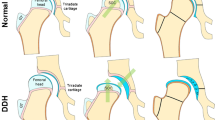Abstract
Introduction
The significance of the relationship between the spine and hip joints has been frequently discussed. However, the relationship between acetabular coverage and spinal sagittal alignment has not been fully elucidated as previous studies did not adequately control for factors that might affect the spinopelvic alignment. The aim of this study was to elucidate the impact of acetabular coverage on spinal sagittal alignment by comparing patient groups matched on sex, age, and the presence of hip and anterior impingement pain.
Materials and methods
We prospectively enrolled 30 women undergoing periacetabular osteotomy (PAO) for developmental dysplasia of the hip (DDH) and 30 women undergoing hip arthroscopic surgery (HAS) for labral tears. The lateral centre edge angle was measured on hip radiographs. In addition, the sagittal vertical axis, pelvic tilt, pelvic incidence, sacral slope (SS), and lumbar lordosis (LL) were measured on preoperative plain radiographs of the whole spine to assess the sagittal spinal alignment. Clinical and radiologic data were compared between the two groups (PAO vs. HAS).
Results
The patient groups did not differ in age and body mass index. The mean SS was significantly greater in the PAO group (41.6° ± 1.6°) than in the HAS group (35.3° ± 1.5°; P = 0.0039). Additionally, the mean LL was significantly greater in the PAO group (54.5° ± 2.0°) than in the HAS group (45.1° ± 1.9°; P = 0.0015).
Conclusions
The SS and LL were greater in patients with DDH than in patients with hip pain, but without DDH. Patients with DDH might show lumbar hyperlordosis to rotate the pelvis anteriorly, increasing the anterosuperior acetabular coverage.


Similar content being viewed by others
References
Harris WH (1986) Etiology of osteoarthritis of the hip. Clin Orthop Relat Res 213:20–33
Weinstein SL, Mubarak SJ, Wenger DR (2014) Fundamental concepts of developmental dysplasia of the hip. Instr Course Lect 63:299–305
Doiguchi Y, Iwasaki K, Yamada K, Takahashi K, Teshima K, Sasamatsu T, Tomita M, Narabashi Y (1992) Correlation between pelvic inclination and radiological shape of the pelvic cavity. Seikei geka to saigai geka (Orthop Traumatol) 41:641–645 (in Japanese)
Offierski CM, MacNab I (1983) Hip-spine syndrome. Spine 8:316–321
Tonnis D (1987) Congenital dysplasia and dislocation of the hip in children and adults. Springer, Berlin
Wyatt M, Weidner J, Pfluger D, Beck M (2017) The femoro-ephiphyseal acetabular roof (FEAR) index: a new measurement associated with instability in borderline hip dysplasia? Clin Orthop Relat Res 475:861–869
Van Roven BJ, Toussaint HM, Kingma I, Bot SD, Caspers M, Harlaar J, Wuisman PI (1998) Accuracy of the sagittal vertical axis in a standing lateral radiograph as a measurement of balance in spinal deformities. Eur Spine J 7:408–412
Duval-Beaupere G, Schmidt C, Cosson P (1992) A barycentremetric study of the sagittal shape of spine and pelvis: the conditions required for an economic standing position. Ann Biomed Eng 20:450–462
Matsuyama Y, Hasegawa Y, Yoshihara H, Tsuji T, Sakai Y, Nakamura H, Kawakami N, Kanemura T, Yukawa Y, Ishiguro N (2004) Hip-spine syndrome: total sagittal alignment of the spine and clinical symptoms in patients with bilateral congenital hip dislocation. Spine 29:2432–2437
Okuda T, Fujita T, Kaneuji A, Miaki K, Yasuda Y, Matsumoto T (2007) Stage-specific sagittal spinopelvic alignment changes in osteoarthritis of the hip secondary to developmental hip dysplasia. Spine 32:E816–E819
Fujii M, Nakashima Y, Noguchi Y, Yamamoto T, Motomura G, Hamai S, Iwamoto Y (2016) Factors associate with severity of intra-articular lesions in patients with severe hip dysplasia. Arthroscopy 32:1581–1589. https://doi.org/10.1016/j.arthro.2016.01.060
Noguchi Y, Miura H, Takasugi S, Iwamoto Y (1999) Cartilage and labrum degeneration in the dysplastic hip generally originates in the anterosuperior weight-bearing area: an arthroscopic observation. Arthroscopy 15:496–506
Genda E, Konishi N, Hasegawa Y, Miura T (1995) A computer simulation study of normal and abnormal hip joint contact pressure. Arch Orthop Trauma Surg 114:202–206
Kalue K, Durnin CW, Ganz R (1991) The acetabular rim syndrome: a clinical presentation of dysplasia of the hip. J Bone Joint Surg Br 73:423–429
Fujii M, Nakashima Y, Sato T, Akiyama M, Iwamoto Y (2012) Acetabular tilt correlates with acetabular version and coverage in hip dysplasia. Clin Orthop Relat Res 470:2827–2835. https://doi.org/10.1007/s11999-012-2370-z
Nunley RM, Prather H, Hunt D, Schonecker PL, Clohisy JC (2011) Clinical presentation of symptomatic acetabular dysplasia in skeletally mature patients. J Bone Joint Surg Am 93(Suppl 2):17–21. https://doi.org/10.2106/JBJS.J.01735
Nakamura J, Oinuma K, Ohtori S, Watanabe A, Shigemura T, Sasho T, Saito M, Suzuki M, Takahashi K, Kishida S (2013) Distribution of hip pain in osteoarthritis patients secondary to developmental dysplasia of the hip. Mod Rheumatol 23:119–124. https://doi.org/10.1007/s10165-012-0638-5
Acknowledgements
We are grateful to Mitsutoshi Moriya, M.D., Yuya Ohtake, M.D., and Shintaro Shoji, M.D. for their helpful support during this study.
Funding
There is no funding source.
Author information
Authors and Affiliations
Corresponding author
Ethics declarations
Conflict of interest
The authors declare that they have no conflict of interest.
Ethical approval
Ethical approval was obtained from our Institutional Review Board (IRB). The study was performed in accordance with the ethical standards laid down in the 1964 Declaration of Helsinki and its later amendments.
Informed consent
Informed consent was obtained from all participants enrolled in this study.
Rights and permissions
About this article
Cite this article
Fukushima, K., Miyagi, M., Inoue, G. et al. Relationship between spinal sagittal alignment and acetabular coverage: a patient-matched control study. Arch Orthop Trauma Surg 138, 1495–1499 (2018). https://doi.org/10.1007/s00402-018-2992-z
Received:
Published:
Issue Date:
DOI: https://doi.org/10.1007/s00402-018-2992-z




